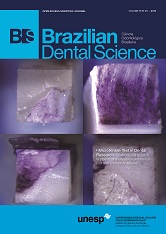Analysis of the volume of autogenous cancellous bone grafts with or without the use of ePTFE membranes in ovariectomized rats.
DOI:
https://doi.org/10.14295/bds.2013.v16i3.880Resumo
Objective: To verify the influence of the osteopeny induced by the bone repairing of the receptor site/autogenous bone graft block interface either associated with or without PTFE-e membrane through the analysis of the trabecular bone volume. Material & Methods: 48 Wistar rats weighing approximately 300 g were submitted to parietal bone graft which was fixed to the lateral wall of the left mandibular ramus. The animals were randomly divided into four groups: Group 1: simulated ovariotomy (SHAM) and autogenous bone graft; Group 2: SHAM and autogenous bone graft through PTFE-e membrane recovering; Group 3: ovariotomy (OVZ) and autogenous bone graft; Group 4: OVZ and autogenous bone graft and PTFE-e membrane recovering. The animals of each group were killed at the following periods: 21, 45 and 60 days, comprising 4 animals per group. The pieces were decalcified and included; the cuts were stained with HE and submitted to histological and histomorphometric analysis through light microscopy. Results: ANOVA test showed that the variables accounting for both the condition (OVZ and SHAM) and the period (21,45 and 60 days) were statistically significant; the Tukey test (5%) showed that the period of 21 days was statistically different from 45 and 60 days; however, they were not statistically different between each other. The descriptive histological analysis showed grafting integration in all animals. Conclusion: the process of graft integration with the receptor site was negatively affected by the induced osteopeny presence and presence or absence of PTFE-e membrane did not interfered in the integration process.
Downloads
Downloads
Publicado
Como Citar
Edição
Seção
Licença
TRANSFERÊNCIA DE DIREITOS AUTORAIS E DECLARAÇÃO DE RESPONSABILIDADE
Toda a propriedade de direitos autorais do artigo "____________________________________________________________________" é transferido do autor(es) para a CIÊNCIA ODONTOLÓGICA BRASILEIRA, no caso do trabalho ser publicado. O artigo não foi publicado em outro lugar e não foi submetido simultaneamente para publicação em outra revista.
Vimos por meio deste, atestar que trabalho é original e não apresenta dados manipulados, fraude ou plágio. Fizemos contribuição científica significativa para o estudo e estamos cientes dos dados apresentados e de acordo com a versão final do artigo. Assumimos total responsabilidade pelos aspectos éticos do estudo.
Este texto deve ser impresso e assinado por todos os autores. A versão digitalizada deverá ser apresentada como arquivo suplementar durante o processo de submissão.




























